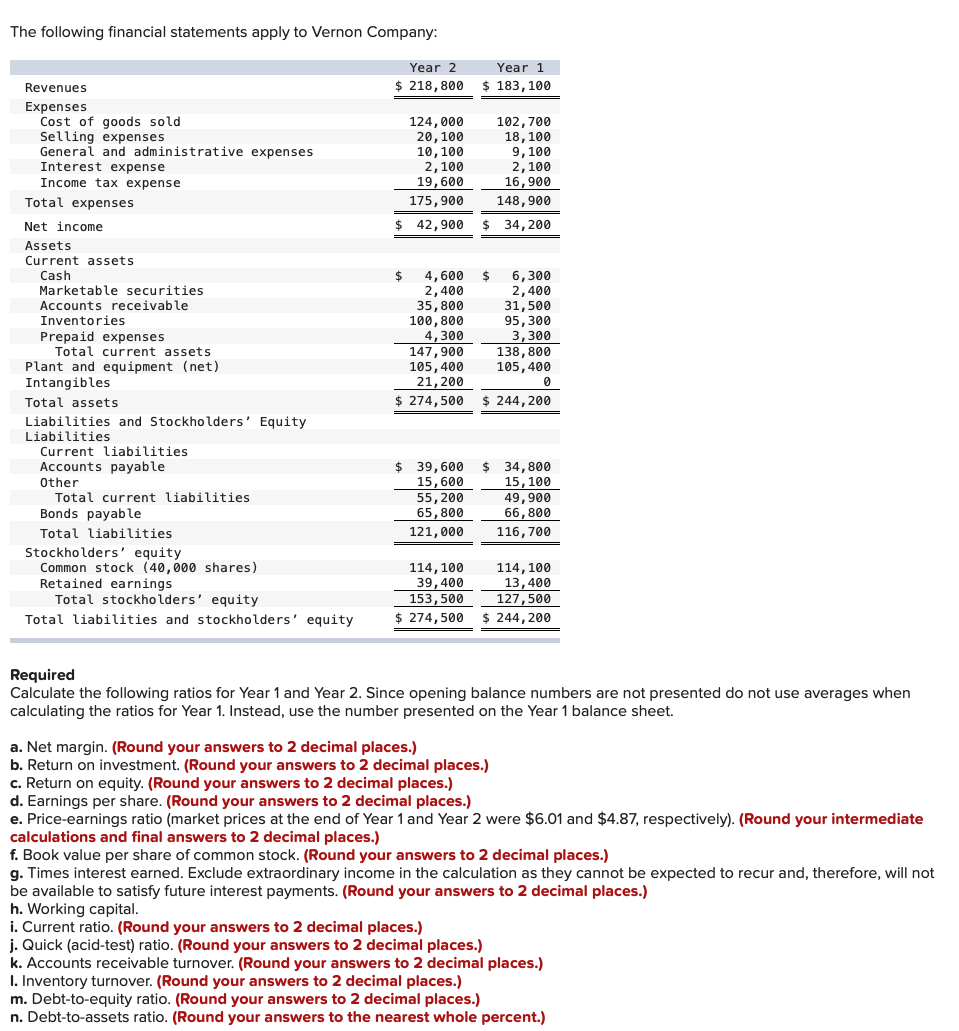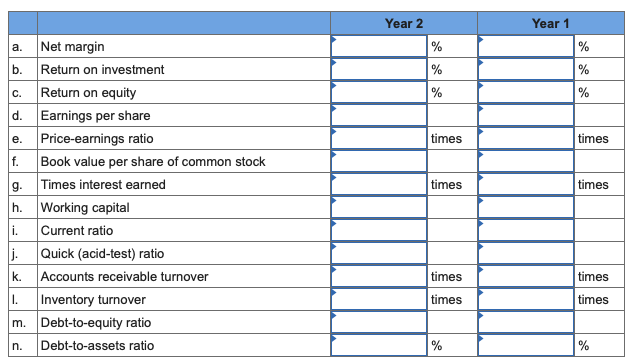

The following financial statements apply to Vernon Company: Year 2 $ 218,800 Year 1 $ 183, 100 Revenues Expenses Cost of goods sold Selling expenses General and administrative expenses Interest expense Income tax expense Total expenses 124,000 20, 100 10, 100 2,100 19,600 175,900 $ 42,900 102,700 18, 100 9, 100 2,100 16,900 148, 900 $ 34,200 $ 4,600 $ 6,300 2,400 2,400 35,800 31,500 100,800 95, 300 4,300 3,300 147,900 138,800 105,400 105,400 21,200 0 $ 274,500 $ 244,200 Net income Assets Current assets Cash Marketable securities Accounts receivable Inventories Prepaid expenses Total current assets Plant and equipment (net) Intangibles Total assets Liabilities and Stockholders' Equity Liabilities Current liabilities Accounts payable Other Total current liabilities Bonds payable Total liabilities Stockholders' equity Common stock (40,000 shares) Retained earnings Total stockholders' equity Total liabilities and stockholders' equity $ 39,600 15,600 55,200 65,800 121,000 $ 34,800 15, 100 49,900 66,800 116,700 114, 100 39,400 153,500 $ 274,500 114, 100 13,400 127,500 $ 244,200 Required Calculate the following ratios for Year 1 and Year 2. Since opening balance numbers are not presented do not use averages when calculating the ratios for Year 1. Instead, use the number presented on the Year 1 balance sheet. a. Net margin. (Round your answers to 2 decimal places.) b. Return on investment. (Round your answers to 2 decimal places.) c. Return on equity. (Round your answers to 2 decimal places.) d. Earnings per share. (Round your answers to 2 decimal places.) e. Price-earnings ratio (market prices at the end of Year 1 and Year 2 were $6.01 and $4.87, respectively). (Round your intermediate calculations and final answers to 2 decimal places.) f. Book value per share of common stock. (Round your answers to 2 decimal places.) g. Times interest earned. Exclude extraordinary income in the calculation as they cannot be expected to recur and, therefore, will not be available to satisfy future interest payments. (Round your answers to 2 decimal places.) h. Working capital. i. Current ratio. (Round your answers to 2 decimal places.) j. Quick (acid-test) ratio. (Round your answers to 2 decimal places.) k. Accounts receivable turnover. (Round your answers to 2 decimal places.) I. Inventory turnover. (Round your answers to 2 decimal places.) m. Debt-to-equity ratio. (Round your answers to 2 decimal places.) n. Debt-to-assets ratio. (Round your answers to the nearest whole percent.) Year 2 Year 1 a. % % % % C. % % e. times times times times Net margin b. Return on investment Return on equity d. Earnings per share Price-earnings ratio f. Book value per share of common stock g. Times interest earned h. Working capital Current ratio 1. Quick (acid-test) ratio Accounts receivable turnover 1. Inventory turnover m. Debt-to-equity ratio Debt-to-assets ratio i. k. times times times times n. % %








